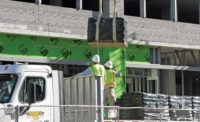More than 50 years ago, contractors realized using factory pre-blended concrete rather than field mixing concrete on job sites was more profitable and delivered better results for pouring slabs. About two decades ago, contractors came to the same conclusion about using factory pre-blended mortar rather than field mixing mortar for laying brick or block. While the direct cost for factory pre-blended materials is slightly higher than field mixing, the mixes provide greater consistency and efficiency on job sites. In addition, using factory pre-blended products reduces labor costs and minimizes material waste. These benefits are magnified when 3,000-pound bulk bags of factory pre-blended material are mixed using a silo system. Today, contractors can enjoy these same performance and cost-saving with factory pre-blended stucco for wall and ceiling jobs.
Finding Consistency and Efficiency
Field mixing stucco requires a concentrate powder that contains Portland cement, lime and other additives, but sand is the backbone to any good stucco mix, and that starts by selecting a sand that meets ASTM C 897 standards. When field mixing, shoveling the exact same amount of sand into a mixer throughout the day is critical. You also have to account for sand bulking, which is added moisture that can affect the volume and weight of a sand measurement. Most sand piles also contain about 5 percent moisture, although that can vary due to environmental conditions like excessive rains or extended dry periods. Not to mention that sand piles can contain impurities like salt or iron that can contribute to efflorescence or streaking. Finally, you have to consider the cost of wasted sand and/or the expense of disposing of leftover sand when field mixing.
Obviously, shoveling sand from piles in the field mixing process doesn’t give contractors or owners the consistently high-quality stucco they desire. A factory pre-blended stucco is a smart alternative that not only assures the appropriate type and amount of sand are used, but also that the proper proportions of Portland, lime, sand, and other additives like fibers are consistent from batch to batch. In addition, factory pre-blend stucco is computer weighed for accuracy and documented at the plant for quality control. Factory pre-blended stucco also eliminates the need and guesswork of adding extra water or dry ingredients during the field mixing process that can skew the material proportions and cause stucco to crack, not bond well or experience other performance failures.
Using one vendor to produce and deliver the factory pre-blended stucco rather than multiple vendors for field mixing also leads to greater performance consistency and helps assure materials show up on schedule, which prevents downtime on the job site. As contractors begin using factory pre-blend stucco, they quickly realize the person at the mixing station can manage more tasks than just mixing mud. In fact, I’ve seen the foreman on a job realize the laborer at the mixing station now has time to operate the forklift because pre-blend stucco requires less time per batch to produce. So, what other ways does using factory pre-blended stucco maximize the profitability of a job?
Managing Labor and Material Costs
Labor is the greatest cost in a wall assembly at about 50 percent with the other components like substrate, lathe, insulation and stucco accounting for the difference. The stucco material actually only represents about 6-8 percent of the cost for the total wall system. Savvy contractors realize that the added value of using a factory pre-blended stucco is worth the extra expense to reduce labor and other overhead on a job. With the support of a reputable manufacturer, reliable technical resources and skilled teams applying the stucco, contractors can spend more time focusing on other opportunities rather than being held hostage to a pile of sand and field mixing. As a result, the increased job site efficiency can lead to lower labor costs, fewer delays, higher quality construction, fewer call backs and more jobs completed each year.
Healthcare is an often overlooked and underappreciated job site expense. According to the Bureau of Labor Statistics, “A total of 626,000 lost workdays each year are due to musculoskeletal disorders and account for $1 of every $3 spent for workers’ compensation.” For example, the average cost of a back injury related claim can run $40,000 to $80,000 per employee. Utilizing factory pre-blend stucco takes the shovel out of the mixer’s hands, reducing the likelihood of back injury. In addition, when using factory pre-blended stucco in 3,000-pound bulk bags placed in a silo system using heavy equipment, there is no repeated lifting of 80-pound bags for field mixing stucco that can also lead to injury. Fewer injuries mean fewer claims and lost man hours as well as unexpected administrative time and expense.
Other benefits of applying factory pre-blended stucco from a silo system with reusable bulk bags include reduced material waste and fewer paper bags in landfills. In addition, factory pre-blend stucco is produced regionally, which helps manage transportation costs and positively contributes to LEED certification efforts. Also, there is no concern with sand run-off from piles in the field mixing process that often requires a containment barrier to prevent the contamination of sewer systems by many municipalities. Avoiding these issues not only eliminates unwanted material and labor costs, but also allows contractors to be good stewards of the environment.
Conclusion
Factory pre-blended stucco is more consistent, requires less time and labor, reduces materials costs and produces higher-quality walls and ceilings than field mixing. As a result, jobs done with factory pre-blended stucco are more profitable, so why wouldn’t you use it on your jobs?





